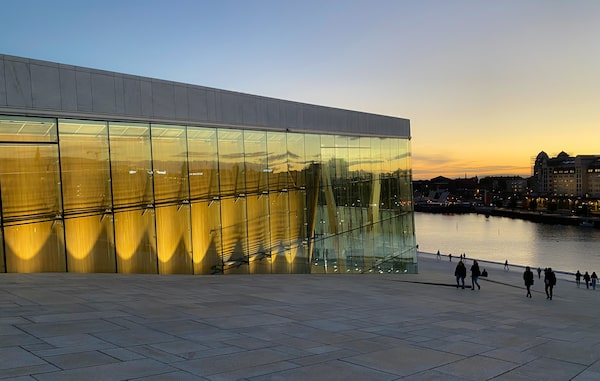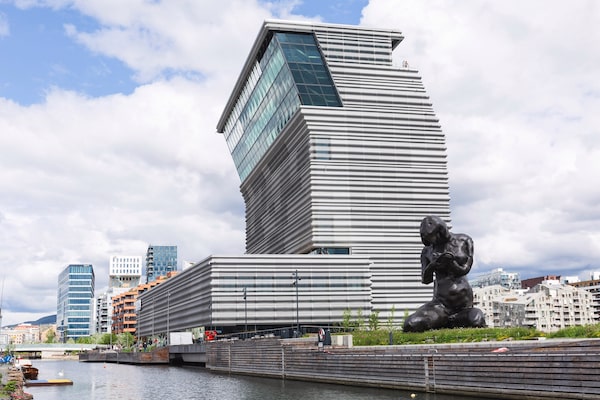
The sculptural, cantilevered Deichman Bjorvika public library opened in 2020.Tord Baklund/Visit OSLO
When I arrived in Oslo on the first beautiful day of spring earlier this year, the city felt jubilant. But it wasn’t just the sunshine and warm temperatures contributing to the energy and optimism.
For much of its history, Norway was Scandinavia’s poor relation, subsisting on forestry, fishing and what little agriculture it could coax out of the short growing season. That abruptly changed in 1969 with the discovery of massive oil reserves, however, and today it is one of the richest nations on Earth. Famously, it controls the world’s largest sovereign wealth fund and has one of the lowest income inequality rankings in the world, sitting first out of 30 on the Inclusiveness Development Index – Canada ranks 15th.
Oslo displays its newfound wealth in a subtle, but proud ways. All around the city new towers rise, many of them of remarkable architectural design, while classic older buildings are lovingly and lavishly restored. The hotel I’m staying at, Sommerro House, is a prime example.
The monumental building with its red brick façade and blend of art deco, functionalist and neoclassical features first opened in 1931 as the headquarters for Oslo Lysverker electric company. In 2022, following a five-year renovation, it reopened as a 232-room hotel and today, thanks to its four restaurants, three bars, rooftop pool, 100-seat theatre, cinema, tricked-out gym, sauna, spa and hammam, it serves as the de facto headquarters for Oslo’s haut monde.

The marble and granite Opera House is like a great glacier rising out of a fjord.Martina Pipprich/Visit OSLO
For guests, the hotel has an almost transformative power. Enjoying an ice-cold martini one evening in the grand Ekspedisjonshallen restaurant beneath its Peter Krohg mural, while the in-house jazz trio explored a rendition of Body and Soul, I got to talking to a visiting American, who told me being in the restaurant made her feel like a secret agent on a covert mission.
A couple of days later, bathing in the rooftop sauna with its panoramic view, I couldn’t help but feel a bit like the scion of a powerful family. Of course, that might have something to do with the fact that an episode of Succession took place at Norway’s spectacular Juvet Landskapshotell, some 400 kilometres to the north.
Back out on the street, where the slanting, subarctic light illuminates the colourful facades of the houses in the St. Olavs Gate, I’m struck by how quiet the city is. At first, I can’t figure out why and then I remember Norway leads the world in the adoption of electric vehicles. Fully one third of the cars on the road operate that way now. Beyond the apparent environmental benefits, it’s amazing how quiet a city becomes when so many internal combustion engines are removed from the roads.

All around Oslo new towers rise, many of them of remarkable architectural design, while classic older buildings are lovingly and lavishly restored.Didrick Stenersen/Visit OSLO
I’m making my way along the hushed streets to the Astrup Fearnley Museet, widely regarded as one of the finest contemporary art museums in Scandinavia. This year marks its 30th anniversary, but the soaring, Renzo Piano-designed building, with its grey timber cladding and gently curving glass roof is just 12 years old.
I’m here to meet with Owen Martin, the museum’s curator. Martin originally hails from Calgary, but was most recently based in Cape Town, South Africa. I ask him what drew him to Oslo. “There’s a sense of a place in transition here,” he explains. “Culturally speaking there’s a sort of confidence and an openness and a willingness to explore new possibilities.” That sensibility is very much evident in the museum’s collection where world-famous works from Jeff Koons, Damien Hirst and Takashi Murakami are displayed alongside works from younger Norwegian artists like Joar Nango, Torbjorn Rodland and Frida Orupabo.
As Martin explains: “Actors in the region who have historically been much more assertive and dominant culturally used to shape the conversation, and then suddenly Norway starts to become this extremely wealthy country and that shifted the dynamic. Consequently, they’ve been able to invite people in from the outside and to imagine things in their own way, drawing upon the cultural practices in the region while also looking elsewhere.”
Such a mix gives great energy to the exhibits and is a conscious choice that reflects Norway’s place in the world. It is an approach echoed in the new, temple-like National Museum. Barely a year old, the sprawling building houses some 400,000 works and curates them in a compelling way: 2,500-year-old Egyptian death figurines are displayed right beside a 2009 Annelise Josefsen sculpture of soldiers dancing and A 600-year-old Ming Dynasty vase sits directly across from a 21st-century sculpture by Norwegian ceramicist Torbjorn Kvasbo.
Oslovians seem happy to embrace global influences and adopt them as they see fit in the culinary world, as well. The international sensibility is as apparent in the barrel-vaulted Art Nouveau ceiling of the Viennese-inspired Theatercafeen. It appears in the eclectic menu at Katla where tostadas sit happily alongside takoyaki and the grilled turbot head comes with spicy Thai nam jim sauce. It animates Vippa, an enormous food court on the edge of a fjord, where vendors turn out everything from Zhajiang noodles to sour cabbage krokiety (Polish croquettes).
Oslo displays its newfound wealth in a subtle, but proud ways.Einar Aslaksen/Handout
At the highest level, however, restaurants like the three Michelin-starred Maaemo – the name derives from an old Norse word meaning “everything that grows” – are recreating Norwegian cuisine through local ingredients. That might mean pairing king crab with smoked reindeer broth and chicken fat, serving potato pancakes with beer steamed langoustines and elm shoots or braiding cinnamon rolls in an ancient Viking pattern.
“Norwegian food culture has much more of its own identity than Danish and Swedish cuisine – and I say this as someone who was born in Denmark,” explains Maaemo’s chef, Esben Holmboe Bang. “Because there was no money here for a long time, the food developed in a very spartan way. It was just about survival: boiled meats, salted meats and salted fish, food meant to get you through the winter. Ultimately, I feel like if you want to talk regional identity, Norway is much more its own thing and even though Oslo is much smaller than Copenhagen or Stockholm, the food scene here is more dynamic. You can sense that something is happening.”
Nowhere is that feeling more apparent than in the Bjorvika district. Here, within a short stroll, I encounter the sculptural, cantilevered Deichman Bjorvika public library (opened in 2020), the towering, aluminum-panelled Munch museum (opened 2021) and, like a great glacier rising out of a fjord, the marble and granite Opera House (opened 2008).
Arriving at the Opera House I join a crowd of onlookers on the roof to appreciate the long, slow setting of the northern sun. As the sky blends from yellow to rusty orange to brick red – the colours of the traditional houses throughout the city – I’m reminded that even in one of the wealthiest nations on the planet, experiences like this are always free.
The writer travelled as a guest of Visit Oslo. It did not review or approve the story before publication.